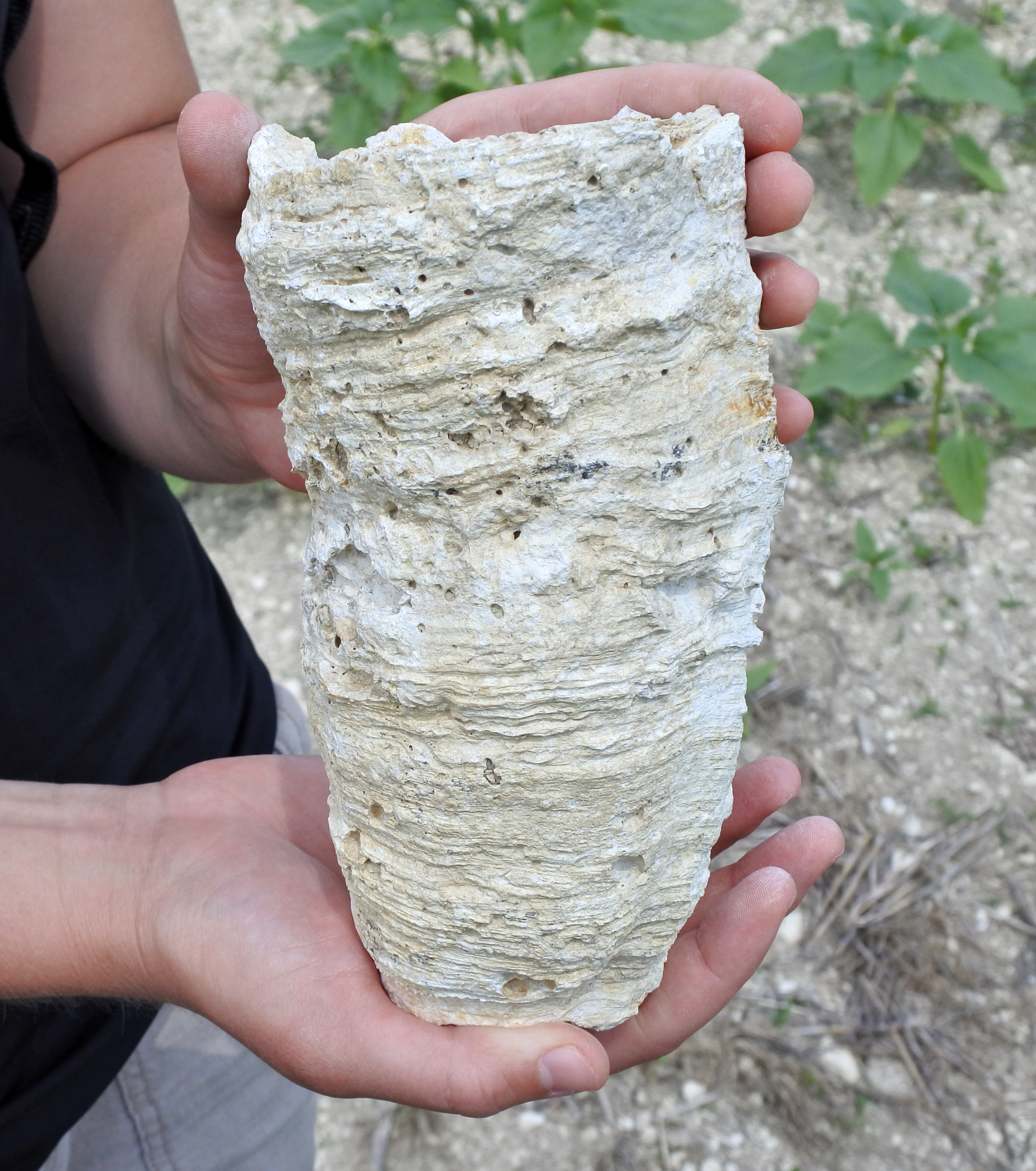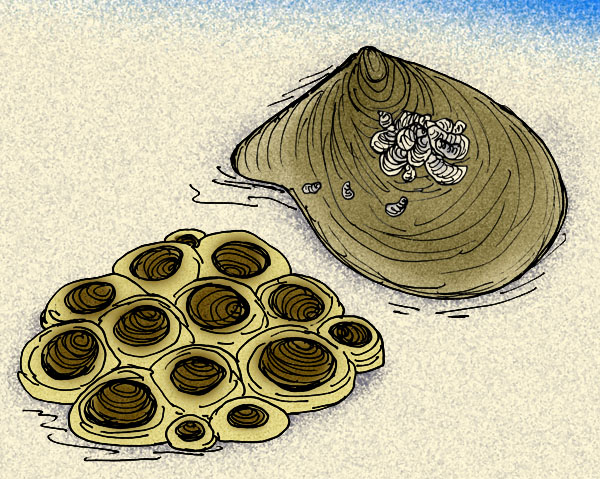Rudist on:
[Wikipedia]
[Google]
[Amazon]
 Rudists are a group of extinct box-, tube- or ring-shaped
Rudists are a group of extinct box-, tube- or ring-shaped
 The classification of rudists as true reef-builders is controversial because they would catch and trap much sediment between their lower conical valves; thus, rudists were not completely composed of biogenic carbonates as a coral would be. However, rudists were one of the most important constituents of
The classification of rudists as true reef-builders is controversial because they would catch and trap much sediment between their lower conical valves; thus, rudists were not completely composed of biogenic carbonates as a coral would be. However, rudists were one of the most important constituents of
 Rudists are a group of extinct box-, tube- or ring-shaped
Rudists are a group of extinct box-, tube- or ring-shaped marine
Marine is an adjective meaning of or pertaining to the sea or ocean.
Marine or marines may refer to:
Ocean
* Maritime (disambiguation)
* Marine art
* Marine biology
* Marine debris
* Marine habitats
* Marine life
* Marine pollution
Military ...
heterodont
In anatomy, a heterodont (from Greek, meaning 'different teeth') is an animal which possesses more than a single tooth morphology.
In vertebrates, heterodont pertains to animals where teeth are differentiated into different forms. For exampl ...
bivalves
Bivalvia (), in previous centuries referred to as the Lamellibranchiata and Pelecypoda, is a class of marine and freshwater molluscs that have laterally compressed bodies enclosed by a shell consisting of two hinged parts. As a group, bival ...
belonging to the order Hippuritida that arose during the Late Jurassic
The Jurassic ( ) is a geologic period and stratigraphic system that spanned from the end of the Triassic Period million years ago (Mya) to the beginning of the Cretaceous Period, approximately Mya. The Jurassic constitutes the middle period of ...
and became so diverse during the Cretaceous
The Cretaceous ( ) is a geological period that lasted from about 145 to 66 million years ago (Mya). It is the third and final period of the Mesozoic Era, as well as the longest. At around 79 million years, it is the longest geological period of ...
that they were major reef-building organisms in the Tethys Ocean
The Tethys Ocean ( el, Τηθύς ''Tēthús''), also called the Tethys Sea or the Neo-Tethys, was a prehistoric ocean that covered most of the Earth during much of the Mesozoic Era and early Cenozoic Era, located between the ancient continents ...
, until their complete extinction at the close of the Cretaceous.
Shell description
The Late Jurassic forms were elongate, with bothvalve
A valve is a device or natural object that regulates, directs or controls the flow of a fluid (gases, liquids, fluidized solids, or slurries) by opening, closing, or partially obstructing various passageways. Valves are technically fitting ...
s being similarly shaped, often pipe or stake-shaped, while the reef-building forms of the Cretaceous had one valve that became a flat lid, with the other valve becoming an inverted spike-like cone. The size of these conical forms ranged widely from just a few centimeters to well over a meter in length.
Their "classic" morphology consisted of a lower, roughly conical valve
A valve is a device or natural object that regulates, directs or controls the flow of a fluid (gases, liquids, fluidized solids, or slurries) by opening, closing, or partially obstructing various passageways. Valves are technically fitting ...
that was attached to the seafloor or to neighboring rudists, and a smaller upper valve that served as a kind of lid for the organism. The small upper valve could take a variety of interesting forms, including: a simple flat lid, a low cone, a spiral, and even a star-shaped form.
Fossil range and extinction
The oldest rudists are found in lateJurassic
The Jurassic ( ) is a geologic period and stratigraphic system that spanned from the end of the Triassic Period million years ago (Mya) to the beginning of the Cretaceous Period, approximately Mya. The Jurassic constitutes the middle period of ...
rocks in France.
The rudists became extinct at the end of the Cretaceous, apparently as a result of the Cretaceous–Paleogene extinction event
The Cretaceous–Paleogene (K–Pg) extinction event (also known as the Cretaceous–Tertiary extinction) was a sudden mass extinction of three-quarters of the plant and animal species on Earth, approximately 66 million years ago. With the ...
. It had been thought that this group began a decline about 2.5 million years earlier which culminated in complete extinction half a million years before the end of the Cretaceous. The extinction of rudist bivalves was stepwise during the Maastrichtian
The Maastrichtian () is, in the ICS geologic timescale, the latest age (uppermost stage) of the Late Cretaceous Epoch or Upper Cretaceous Series, the Cretaceous Period or System, and of the Mesozoic Era or Erathem. It spanned the inte ...
(end of the Cretaceous
The Cretaceous ( ) is a geological period that lasted from about 145 to 66 million years ago (Mya). It is the third and final period of the Mesozoic Era, as well as the longest. At around 79 million years, it is the longest geological period of ...
).
Taxonomy
The rudists are, according to different systematic schemes, placed in theorders
Order, ORDER or Orders may refer to:
* Categorization, the process in which ideas and objects are recognized, differentiated, and understood
* Heterarchy, a system of organization wherein the elements have the potential to be ranked a number of ...
Hippuritida (Hippuritoida) or Rudistes (sometimes Rudista).
Order: †Hippuritida
* Suborder: † Hippuritidina
** Superfamily: † Caprinoidea
*** Family: † Antillocaprinidae
*** Family: † Caprinidae
***Family: † Caprinuloideidae
*** Family: † Ichthyosarcolitidae
** Superfamily: † Radiolitoidea
*** Family: † Caprotinidae
*** Family: † Diceratidae
*** Family: † Hippuritidae
*** Family: † Plagioptychidae
*** Family: † Polyconitidae
*** Family: †Radiolitidae
''Radiolitidae'' is a family of rudists in the order Hippuritida.
Fossil record
These rudists lived between the Jurassic and the Cretaceous (age range: 130.0 to 66.043 million years ago).
Genera
Genera within this family include:
* † '' Agri ...
* Suborder: † Requieniidina
** Superfamily: † Requienioidea
*** Family: † Requieniidae
***Family: † Epidiceratidae
Bieler, Carter & Coan in 2010 also named the non-Hippuritid families Megalodontoidea and Chamoidea, of Megalodontida and Venerida
Venerida (formerly Veneroida) is an order of mostly saltwater but also some freshwater bivalve molluscs. This order includes many familiar groups such as many clams that are valued for food and a number of freshwater bivalves.
Since the 2000s, t ...
respectively, as "Rudists", but this classification was not monophyletic
In cladistics for a group of organisms, monophyly is the condition of being a clade—that is, a group of taxa composed only of a common ancestor (or more precisely an ancestral population) and all of its lineal descendants. Monophyletic gr ...
.
Ecology
 The classification of rudists as true reef-builders is controversial because they would catch and trap much sediment between their lower conical valves; thus, rudists were not completely composed of biogenic carbonates as a coral would be. However, rudists were one of the most important constituents of
The classification of rudists as true reef-builders is controversial because they would catch and trap much sediment between their lower conical valves; thus, rudists were not completely composed of biogenic carbonates as a coral would be. However, rudists were one of the most important constituents of reefs
A reef is a ridge or shoal of rock, coral or similar relatively stable material, lying beneath the surface of a natural body of water. Many reefs result from natural, abiotic processes—deposition of sand, wave erosion planing down rock out ...
during the Cretaceous Period. During the Cretaceous, rudist reefs were so successful that they may have driven scleractinia
Scleractinia, also called stony corals or hard corals, are marine animals in the phylum Cnidaria that build themselves a hard skeleton. The individual animals are known as polyps and have a cylindrical body crowned by an oral disc in which a ...
n corals out of many tropical environments, including shelves that are today the Caribbean
The Caribbean (, ) ( es, El Caribe; french: la Caraïbe; ht, Karayib; nl, De Caraïben) is a region of the Americas that consists of the Caribbean Sea, its islands (some surrounded by the Caribbean Sea and some bordering both the Caribbean ...
and the Mediterranean
The Mediterranean Sea is a sea connected to the Atlantic Ocean, surrounded by the Mediterranean Basin and almost completely enclosed by land: on the north by Western and Southern Europe and Anatolia, on the south by North Africa, and on ...
. It is likely that their success as reef builders was at least partially due to the extreme environment of the Cretaceous. During this period tropical waters were between 6°C and 14°C warmer than today and also more highly saline, and while this may have been a suitable environment for the rudists, it was not nearly so hospitable to corals and other contemporary reef builders. These rudist reefs were sometimes hundreds of meters tall and often ran for hundreds of kilometers on continental shelves; in fact at one point they fringed the North America
North America is a continent in the Northern Hemisphere and almost entirely within the Western Hemisphere. It is bordered to the north by the Arctic Ocean, to the east by the Atlantic Ocean, to the southeast by South America and th ...
n coast from the Gulf of Mexico
The Gulf of Mexico ( es, Golfo de México) is an ocean basin and a marginal sea of the Atlantic Ocean, largely surrounded by the North American continent. It is bounded on the northeast, north and northwest by the Gulf Coast of the United ...
to the present-day Maritime Provinces
The Maritimes, also called the Maritime provinces, is a region of Eastern Canada consisting of three provinces: New Brunswick, Nova Scotia, and Prince Edward Island. The Maritimes had a population of 1,899,324 in 2021, which makes up 5.1% o ...
. Because of their high porosity
Porosity or void fraction is a measure of the void (i.e. "empty") spaces in a material, and is a fraction of the volume of voids over the total volume, between 0 and 1, or as a percentage between 0% and 100%. Strictly speaking, some tests measur ...
, rudist reefs are highly favored oil traps.
References
* *External links
* * {{Taxonbar, from=Q29877474 Prehistoric bivalves Jurassic first appearances Maastrichtian extinctions